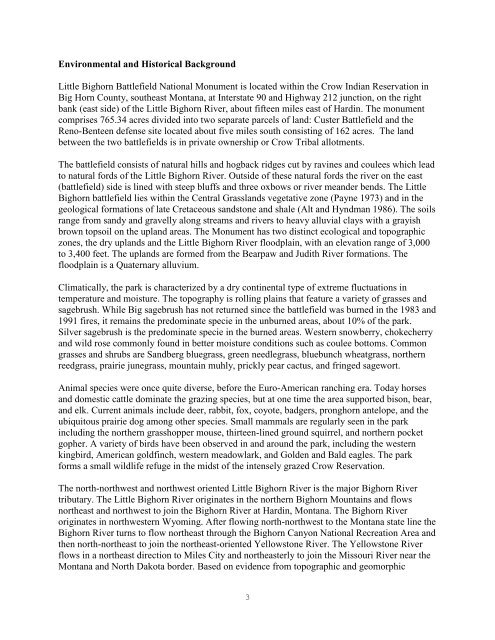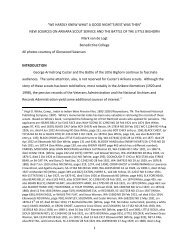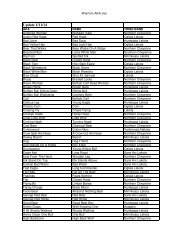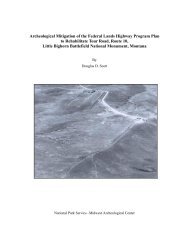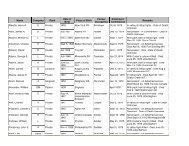Investigating the Oxbows and Testing Metal Detector Efficiency
Investigating the Oxbows and Testing Metal Detector Efficiency
Investigating the Oxbows and Testing Metal Detector Efficiency
You also want an ePaper? Increase the reach of your titles
YUMPU automatically turns print PDFs into web optimized ePapers that Google loves.
Environmental <strong>and</strong> Historical Background<br />
Little Bighorn Battlefield National Monument is located within <strong>the</strong> Crow Indian Reservation in<br />
Big Horn County, sou<strong>the</strong>ast Montana, at Interstate 90 <strong>and</strong> Highway 212 junction, on <strong>the</strong> right<br />
bank (east side) of <strong>the</strong> Little Bighorn River, about fifteen miles east of Hardin. The monument<br />
comprises 765.34 acres divided into two separate parcels of l<strong>and</strong>: Custer Battlefield <strong>and</strong> <strong>the</strong><br />
Reno-Benteen defense site located about five miles south consisting of 162 acres. The l<strong>and</strong><br />
between <strong>the</strong> two battlefields is in private ownership or Crow Tribal allotments.<br />
The battlefield consists of natural hills <strong>and</strong> hogback ridges cut by ravines <strong>and</strong> coulees which lead<br />
to natural fords of <strong>the</strong> Little Bighorn River. Outside of <strong>the</strong>se natural fords <strong>the</strong> river on <strong>the</strong> east<br />
(battlefield) side is lined with steep bluffs <strong>and</strong> three oxbows or river me<strong>and</strong>er bends. The Little<br />
Bighorn battlefield lies within <strong>the</strong> Central Grassl<strong>and</strong>s vegetative zone (Payne 1973) <strong>and</strong> in <strong>the</strong><br />
geological formations of late Cretaceous s<strong>and</strong>stone <strong>and</strong> shale (Alt <strong>and</strong> Hyndman 1986). The soils<br />
range from s<strong>and</strong>y <strong>and</strong> gravelly along streams <strong>and</strong> rivers to heavy alluvial clays with a grayish<br />
brown topsoil on <strong>the</strong> upl<strong>and</strong> areas. The Monument has two distinct ecological <strong>and</strong> topographic<br />
zones, <strong>the</strong> dry upl<strong>and</strong>s <strong>and</strong> <strong>the</strong> Little Bighorn River floodplain, with an elevation range of 3,000<br />
to 3,400 feet. The upl<strong>and</strong>s are formed from <strong>the</strong> Bearpaw <strong>and</strong> Judith River formations. The<br />
floodplain is a Quaternary alluvium.<br />
Climatically, <strong>the</strong> park is characterized by a dry continental type of extreme fluctuations in<br />
temperature <strong>and</strong> moisture. The topography is rolling plains that feature a variety of grasses <strong>and</strong><br />
sagebrush. While Big sagebrush has not returned since <strong>the</strong> battlefield was burned in <strong>the</strong> 1983 <strong>and</strong><br />
1991 fires, it remains <strong>the</strong> predominate specie in <strong>the</strong> unburned areas, about 10% of <strong>the</strong> park.<br />
Silver sagebrush is <strong>the</strong> predominate specie in <strong>the</strong> burned areas. Western snowberry, chokecherry<br />
<strong>and</strong> wild rose commonly found in better moisture conditions such as coulee bottoms. Common<br />
grasses <strong>and</strong> shrubs are S<strong>and</strong>berg bluegrass, green needlegrass, bluebunch wheatgrass, nor<strong>the</strong>rn<br />
reedgrass, prairie junegrass, mountain muhly, prickly pear cactus, <strong>and</strong> fringed sagewort.<br />
Animal species were once quite diverse, before <strong>the</strong> Euro-American ranching era. Today horses<br />
<strong>and</strong> domestic cattle dominate <strong>the</strong> grazing species, but at one time <strong>the</strong> area supported bison, bear,<br />
<strong>and</strong> elk. Current animals include deer, rabbit, fox, coyote, badgers, pronghorn antelope, <strong>and</strong> <strong>the</strong><br />
ubiquitous prairie dog among o<strong>the</strong>r species. Small mammals are regularly seen in <strong>the</strong> park<br />
including <strong>the</strong> nor<strong>the</strong>rn grasshopper mouse, thirteen-lined ground squirrel, <strong>and</strong> nor<strong>the</strong>rn pocket<br />
gopher. A variety of birds have been observed in <strong>and</strong> around <strong>the</strong> park, including <strong>the</strong> western<br />
kingbird, American goldfinch, western meadowlark, <strong>and</strong> Golden <strong>and</strong> Bald eagles. The park<br />
forms a small wildlife refuge in <strong>the</strong> midst of <strong>the</strong> intensely grazed Crow Reservation.<br />
The north-northwest <strong>and</strong> northwest oriented Little Bighorn River is <strong>the</strong> major Bighorn River<br />
tributary. The Little Bighorn River originates in <strong>the</strong> nor<strong>the</strong>rn Bighorn Mountains <strong>and</strong> flows<br />
nor<strong>the</strong>ast <strong>and</strong> northwest to join <strong>the</strong> Bighorn River at Hardin, Montana. The Bighorn River<br />
originates in northwestern Wyoming. After flowing north-northwest to <strong>the</strong> Montana state line <strong>the</strong><br />
Bighorn River turns to flow nor<strong>the</strong>ast through <strong>the</strong> Bighorn Canyon National Recreation Area <strong>and</strong><br />
<strong>the</strong>n north-nor<strong>the</strong>ast to join <strong>the</strong> nor<strong>the</strong>ast-oriented Yellowstone River. The Yellowstone River<br />
flows in a nor<strong>the</strong>ast direction to Miles City <strong>and</strong> nor<strong>the</strong>asterly to join <strong>the</strong> Missouri River near <strong>the</strong><br />
Montana <strong>and</strong> North Dakota border. Based on evidence from topographic <strong>and</strong> geomorphic<br />
3


